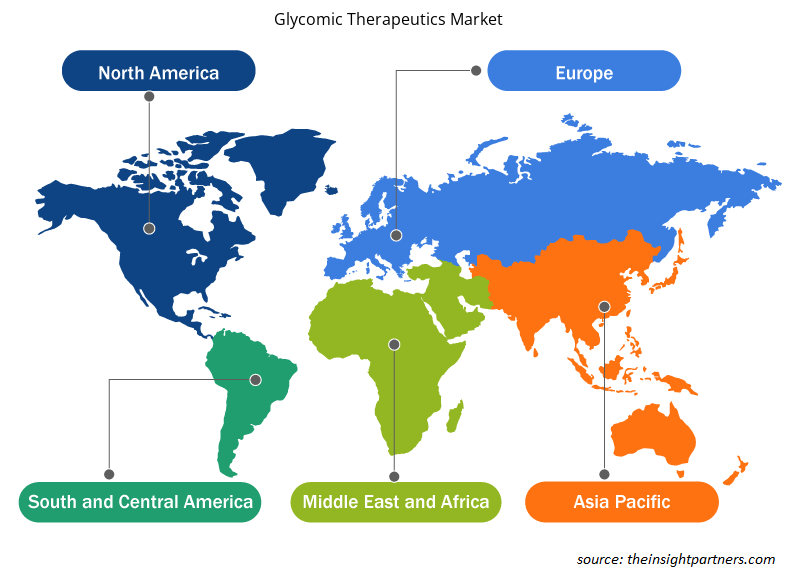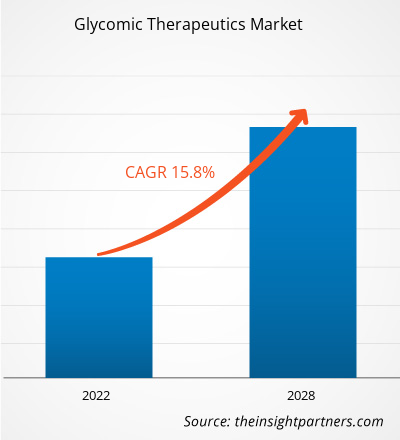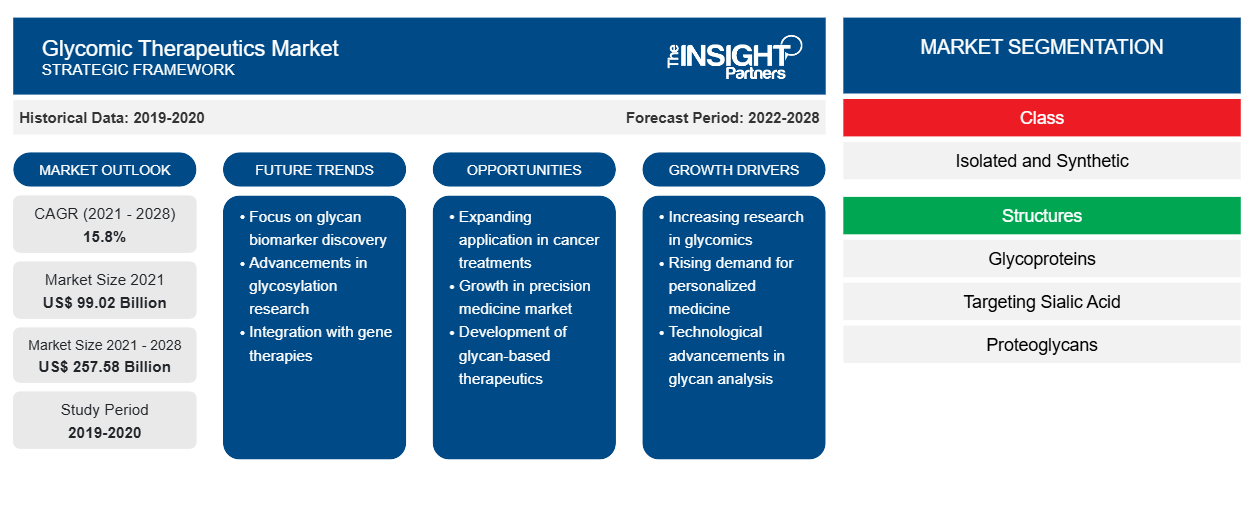Der Markt für Glykomtherapeutika soll von 99.021,46 Millionen US-Dollar im Jahr 2021 auf 257.578,79 Millionen US-Dollar im Jahr 2028 wachsen; von 2022 bis 2028 wird mit einer durchschnittlichen jährlichen Wachstumsrate von 15,8 % gerechnet .glycomic therapeutics market is expected to grow from US$ 99,021.46 million in CAGR of 15.8% from 2022
Der Bericht hebt die vorherrschenden Trends und Faktoren hervor, die das Marktwachstum vorantreiben. Die Glykomik konzentriert sich auf die Strukturen und Funktionen komplexer Kohlenhydrate, wie sie in Glykoproteinen, Glykolipiden und Glykosaminoglykanen vorkommen. Glykane sind für einen Großteil der strukturellen Variation in biologischen Systemen verantwortlich, und ihre Darstellung auf Zelloberflächen wird allgemein als „Glykom“ bezeichnet. Diese Glykane sind in vielen Bereichen des Mikrobioms vorhanden, einschließlich Zelloberflächen und Proteinen, und können unglaublich komplex sein. Die mikrobielle Glykomik wird die Krankheitsdiagnose, die Krebserkennung, die personalisierte Medizin, antimikrobielle Impfstoffe und die Arzneimittelentdeckung revolutionieren. Als Therapeutika können glykanintegrierte Nanomaterialien als Impfstoff gegen virale und bakterielle Infektionen und Krebszellen eingesetzt werden.
Der Bericht bietet Einblicke und eine eingehende Analyse des globalen Marktes für Glykomtherapeutika und hebt dabei verschiedene Parameter hervor, darunter Markttrends, technologische Fortschritte, Marktdynamik und eine Wettbewerbslandschaftsanalyse der weltweit führenden Marktteilnehmer. Er umfasst auch die Auswirkungen der COVID-19-Pandemie auf den Markt in allen Regionen. Die Gesamtauswirkungen der COVID-19-Pandemie auf den Markt für Glykomtherapeutika waren gemischt; daher gewinnt der Markt immer noch an Dynamik und wird in den kommenden Jahren voraussichtlich wachsen. Die Gesundheitssysteme waren überlastet und die Bereitstellung medizinischer Versorgung für alle Patienten wurde zu einer Herausforderung. Darüber hinaus war die Biotechnologiebranche mit den unerwünschten Auswirkungen der Pandemie konfrontiert. Während der COVID-19-Pandemie hatten Hersteller medizinischer Geräte Schwierigkeiten, ihren Betrieb zu verwalten. Viele Unternehmen für Glykomtherapeutika hatten ihre Geschäftstätigkeit in den USA, und die Pandemie hat mehrere Unternehmen schwer getroffen. Nachdem sich die Pandemiebeschränkungen jedoch normalisiert hatten, kehrte das Volumen der chirurgischen Eingriffe auf ein normales Niveau zurück. Allmählich nahmen die Krankenhäuser die planmäßigen Eingriffe wieder auf, da die Genesungsrate von COVID-19 zunahm. Auch die Nachfrage nach Glykan-basierten Arzneimitteln in der medizinischen Therapie und Impfstoffentwicklung ist gestiegen.
Passen Sie diesen Bericht Ihren Anforderungen an
Sie erhalten kostenlose Anpassungen an jedem Bericht, einschließlich Teilen dieses Berichts oder einer Analyse auf Länderebene, eines Excel-Datenpakets sowie tolle Angebote und Rabatte für Start-ups und Universitäten.
-
Holen Sie sich die wichtigsten Markttrends aus diesem Bericht.Dieses KOSTENLOSE Beispiel umfasst eine Datenanalyse von Markttrends bis hin zu Schätzungen und Prognosen.
Geographiebasierte Erkenntnisse
Geografisch ist der globale Markt für Glykomtherapeutika in Nordamerika (USA, Kanada und Mexiko), Europa (Großbritannien, Deutschland, Frankreich, Italien, Spanien und das übrige Europa), den asiatisch-pazifischen Raum (China, Japan, Indien, Australien, Südkorea und den übrigen asiatisch-pazifischen Raum), den Nahen Osten und Afrika (die Vereinigten Arabischen Emirate, Saudi-Arabien, Südafrika und den übrigen Nahen Osten und Afrika) sowie Süd- und Mittelamerika (Brasilien, Argentinien und den übrigen Süd- und Mittelamerika) unterteilt.
Markteinblicke
Zunehmende Forschung und Entwicklung im Bereich der Glykomtherapie
Glykane sind äußerst komplex und kommen in vielen Bereichen der Mikrobiomkomponenten vor, beispielsweise in Proteinen und Zelloberflächen. Forscher und Akteure sind aktiv in der Glykomikbranche tätig und konzentrieren sich ständig auf technologische Entwicklungen, um bessere Alternativen zu herkömmlichen Techniken anzubieten. Im Folgenden sind einige Beispiele für Forschung und Entwicklung auf dem Markt für Glykomiktherapeutika aufgeführt:
- Im Februar 2022 vergab die National Science Foundation (NSF) rund 23 Millionen US-Dollar an eine neue Partnerschaft mehrerer Universitäten, die gemeinsam von Virginia Tech und der University of Georgia geleitet wird, um die Glykomaterialforschung in den USA voranzutreiben. Diese Partnerschaft brachte Spitzenwissenschaftler und Ingenieure dieser Institutionen sowie der Brandeis University, des Rensselaer Polytechnic Institute und der University of North Carolina in Chapel Hill zusammen, um ein nationales Forschungszentrum für Glykomaterialien zu gründen.
- Im März 2022 gab Palleon Pharmaceuticals, ein Pionierunternehmen auf dem Gebiet der Glykol-Immunologie zur Behandlung von Krebs und entzündlichen Erkrankungen, die Dosierung des ersten Patienten in der Phase-1/2-Studie des Unternehmens zu E-602 bei Patienten mit fortgeschrittenem Krebs bekannt. Die Studie mit dem Namen GLIMMER-01 (Glycan-Immune Regulation) ist die erste klinische Studie zu Palleons neuartigem Ansatz zur Krebsimmuntherapie, der auf immunsuppressive Sialoglycane abzielt.
- Im April 2022 entwickelten die Glykoproteomik-Forscher des CPTAC eine „Peptide-First“-Methode zur multiattributiven Glykanidentifizierung.
- Im März 2022 deckten japanische Forscher den genauen Mechanismus eines Beta-1,2-Glucan-assoziierten Enzyms auf und lieferten damit neue Erkenntnisse zum komplexen Zuckerstoffwechsel. Ein Forscherteam der Niigata University und der Tokyo University of Science identifizierte die Struktur und Funktion eines neuen Enzyms mit Glycosyltransferase-Aktivität. Die Ergebnisse dieser Untersuchung wurden am 19. Januar 2022 veröffentlicht und im Journal of Biological Chemistry, Band 298, Ausgabe 3, abgedruckt.
- Laut einer im Februar 2022 veröffentlichten Studie von Forschern des Zentrums für Glykomik der Universität Kopenhagen kann Heparin durch Glykomikstudien nun ohne den Einsatz von Tieren hergestellt werden.
- Im Februar 2022 feierte GlycoMIP, ein nationales Forschungszentrum mit Schwerpunkt auf Glykomaterialforschung, das gemeinsam von Virginia Tech und der University of Georgia geleitet wird, die feierliche Eröffnung seiner nationalen Benutzereinrichtung mit feierlichen Eröffnungszeremonien an beiden Universitäten. GlycoMIP wird landesweite Engpässe bei der Glykomaterialsynthese, der Computermodellierung, der Materialcharakterisierung und dem Wissensaustausch durch bahnbrechende Forschung und eine einzigartige nationale Benutzereinrichtung beheben, die der wissenschaftlichen Gemeinschaft wichtige Werkzeuge und Dienste zur Verfügung stellen wird.
Solche Fortschritte auf dem Gebiet der Glykomik treiben das Wachstum des Marktes für Glykomik-Therapeutika erheblich voran.
Klassenbasierte Einblicke
Basierend auf der Klasse ist der Markt für Glykomtherapeutika in isolierte und synthetische unterteilt. Im Jahr 2021 hatte das synthetische Segment einen größeren Marktanteil. Es wird jedoch erwartet, dass das isolierte Segment im Prognosezeitraum eine höhere durchschnittliche jährliche Wachstumsrate (CAGR) von 16,3 % verzeichnet.
Strukturbasierte Erkenntnisse
Basierend auf Strukturen ist der Markt für Glykomtherapeutika segmentiert in Glykoproteine, die auf Sialinsäure abzielen, Proteoglykane, die auf Glykosaminoglykane abzielen, Glykophosphatidylinositol (GPI)-verankerte Proteine und Heparin-basierte Glykane, die auf Glykosphingolipide abzielen und andere. Das Segment Glykoproteine hatte 2021 den größten Marktanteil. Es wird jedoch erwartet, dass das Segment der auf Sialinsäure abzielenden Glykotherapeutika im Prognosezeitraum die höchste durchschnittliche jährliche Wachstumsrate verzeichnet.
Indikationsbasierte Erkenntnisse
Basierend auf der Indikation ist der Markt für Glykom-Therapeutika segmentiert in Thrombose und Chemoprophylaxe, Anämie, Antiadhäsiv- und Entzündungshemmer, Katarakt, Morbus Gaucher , MPS-1 und IV, Krebs, Alzheimer-Krankheit, Influenza Typ A und B und andere. Das Segment Influenza Typ A und B hatte 2021 den größten Marktanteil und es wird erwartet, dass sich im Prognosezeitraum ein ähnlicher Trend fortsetzt.
Regionale Einblicke in den Markt für Glykomtherapeutika
Die regionalen Trends und Faktoren, die den Markt für Glykom-Therapeutika im Prognosezeitraum beeinflussen, wurden von den Analysten von Insight Partners ausführlich erläutert. In diesem Abschnitt werden auch die Marktsegmente und die Geografie von Glykom-Therapeutika in Nordamerika, Europa, im asiatisch-pazifischen Raum, im Nahen Osten und Afrika sowie in Süd- und Mittelamerika erörtert.

- Erhalten Sie regionale Daten zum Markt für Glykomtherapeutika
Umfang des Marktberichts zu Glykomtherapeutika
| Berichtsattribut | Details |
|---|---|
| Marktgröße im Jahr 2021 | 99,02 Milliarden US-Dollar |
| Marktgröße bis 2028 | 257,58 Milliarden US-Dollar |
| Globale CAGR (2021 - 2028) | 15,8 % |
| Historische Daten | 2019-2020 |
| Prognosezeitraum | 2022–2028 |
| Abgedeckte Segmente |
Nach Klasse
|
| Abgedeckte Regionen und Länder |
Nordamerika
|
| Marktführer und wichtige Unternehmensprofile |
|
Marktteilnehmerdichte für Glykomtherapeutika: Auswirkungen auf die Geschäftsdynamik verstehen
Der Markt für Glykomtherapeutika wächst rasant, angetrieben durch die steigende Nachfrage der Endverbraucher aufgrund von Faktoren wie sich entwickelnden Verbraucherpräferenzen, technologischen Fortschritten und einem größeren Bewusstsein für die Vorteile des Produkts. Mit steigender Nachfrage erweitern Unternehmen ihr Angebot, entwickeln Innovationen, um die Bedürfnisse der Verbraucher zu erfüllen, und nutzen neue Trends, was das Marktwachstum weiter ankurbelt.
Die Marktteilnehmerdichte bezieht sich auf die Verteilung der Firmen oder Unternehmen, die in einem bestimmten Markt oder einer bestimmten Branche tätig sind. Sie gibt an, wie viele Wettbewerber (Marktteilnehmer) in einem bestimmten Marktraum im Verhältnis zu seiner Größe oder seinem gesamten Marktwert präsent sind.
Die wichtigsten auf dem Markt für Glykomtherapeutika tätigen Unternehmen sind:
- Intellihep GmbH
- Protalix Biotherapeutika
- BioMarin Pharmaceutical Inc.
- Genzyme Corporation (Sanofi)
- Halozyme Therapeutics, Inc.
Haftungsausschluss : Die oben aufgeführten Unternehmen sind nicht in einer bestimmten Reihenfolge aufgeführt.

- Überblick über die wichtigsten Akteure auf dem Markt für Glykomtherapeutika
Wirkungsweisebasierte Erkenntnisse
Basierend auf der Wirkungsweise ist der Markt für Glykomtherapeutika segmentiert in Hemmer der Neuraminidase; Hemmer der Heparanase und Selektine und Blockierung der Wechselwirkungen zwischen Wachstumsfaktoren und Heparansulfat; Erythropoietin und Enzymersatztherapie (ERT) ; Gewebeplasminogenaktivator; Hemmer der Glucosylceramidsynthase; Interleukin 1, 2 und 3; Beta- und Gamma-Interferone; und andere. Im Jahr 2021 hielt das Segment Erythropoietin und Enzymersatztherapie (ERT) den größten Marktanteil. Es wird jedoch erwartet, dass das Segment Hemmer der Neuraminidase im Prognosezeitraum die höchste durchschnittliche jährliche Wachstumsrate verzeichnet.
Intellihep Ltd; Protalix Biotherapeutics; BioMarin Pharmaceutical Inc.; Genzyme Corporation (Sanofi); Halozyme Therapeutics, Inc.; Bayer AG; Alzheon, Inc.; GlycoMar; GlaxoSmithKline plc.; und F. Hoffmann-La Roche Ltd gehören zu den führenden Akteuren auf dem Markt für Glykomtherapeutika. Diese Unternehmen haben verschiedene Strategien umgesetzt, die ihr Wachstum gefördert haben, was zu mehreren Entwicklungen auf dem Markt geführt hat.
- Historische Analyse (2 Jahre), Basisjahr, Prognose (7 Jahre) mit CAGR
- PEST- und SWOT-Analyse
- Marktgröße Wert/Volumen – Global, Regional, Land
- Branchen- und Wettbewerbslandschaft
- Excel-Datensatz
Aktuelle Berichte
Erfahrungsberichte
Grund zum Kauf
- Fundierte Entscheidungsfindung
- Marktdynamik verstehen
- Wettbewerbsanalyse
- Kundeneinblicke
- Marktprognosen
- Risikominimierung
- Strategische Planung
- Investitionsbegründung
- Identifizierung neuer Märkte
- Verbesserung von Marketingstrategien
- Steigerung der Betriebseffizienz
- Anpassung an regulatorische Trends























 Kostenlose Probe anfordern für - Markt für Glykomtherapeutika
Kostenlose Probe anfordern für - Markt für Glykomtherapeutika